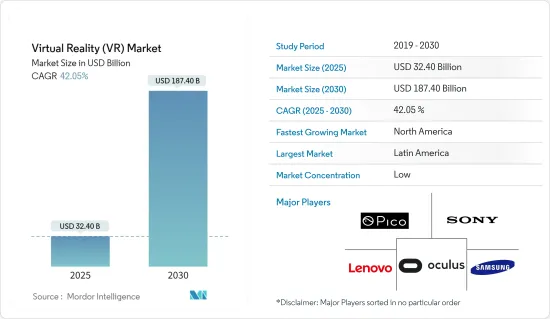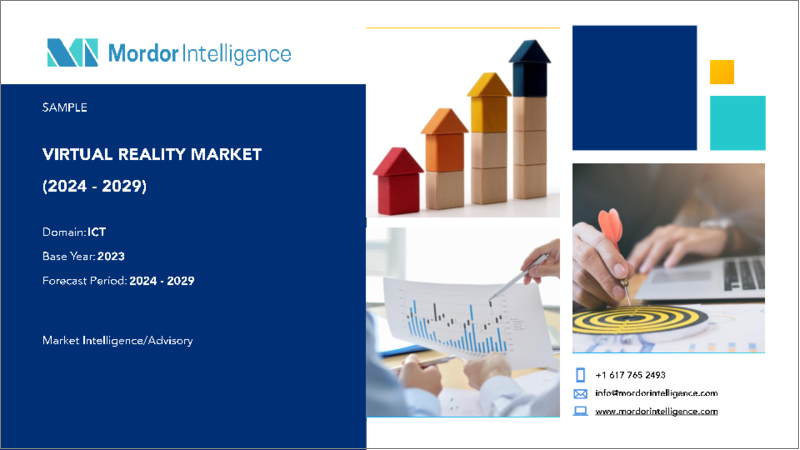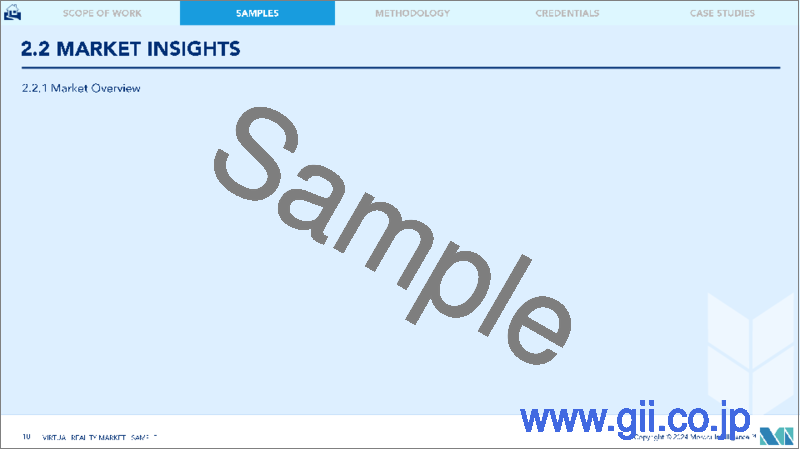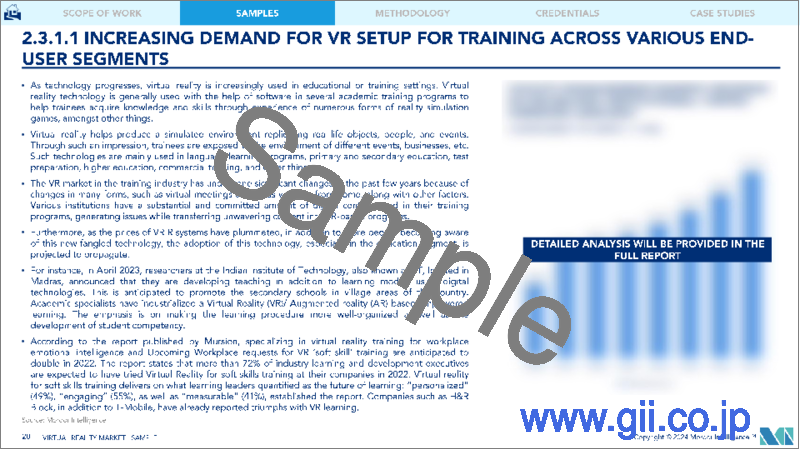|
|
市場調査レポート
商品コード
1685698
バーチャルリアリティ(VR)-市場シェア分析、産業動向・統計、成長予測(2024年~2029年)Virtual Reality (VR) - Market Share Analysis, Industry Trends & Statistics, Growth Forecasts (2024 - 2029) |
||||||
カスタマイズ可能
適宜更新あり
|
|||||||
| バーチャルリアリティ(VR)-市場シェア分析、産業動向・統計、成長予測(2024年~2029年) |
|
出版日: 2025年03月18日
発行: Mordor Intelligence
ページ情報: 英文 153 Pages
納期: 2~3営業日
|
- 全表示
- 概要
- 目次
バーチャルリアリティ市場規模は2024年に228億1,000万米ドルと推定され、2029年には1,319億3,000万米ドルに達すると予測され、予測期間中(2024年~2029年)のCAGRは42.05%で成長する見込みです。

主なハイライト
- バーチャルリアリティは、主に技術を利用してシミュレーション環境を作り出します。従来のユーザー・インターフェースとは異なり、VRはユーザーを体験の中に入れます。つまり、目の前のモニター画面を見る代わりに、ユーザーは没入して3D世界と対話することができます。視覚、触覚、聴覚、さらには嗅覚など、可能な限り多くの感覚をシミュレートすることで、この技術は世界中で変貌を遂げています。
- 学校がVR技術を活用する最も人気のある理由の1つは、生徒がバーチャルで遠足に行けることです。遠足は教育機関にとって古くからの伝統です。教師が没入型の環境で生徒を教育し、教室内では実現が難しい実践的な学習の機会を提供できるからです。しかし、遠足は、生徒によっては経済的に困難な場合もあります。また、移動に制限のある生徒にとっては、困難な場合もあります。
- リモートワークやバーチャルコラボレーションの増加に伴い、バーチャルスペースでの交流やコラボレーションを可能にするVRソフトウェアへの需要が高まっています。VRミーティング・プラットフォーム、バーチャル・イベント・スペース、コラボレーティブ・デザイン・ツールにより、ユーザーは物理的な場所に関係なく、没入感のあるバーチャル環境で共同作業を行うことができます。また、医療トレーニング、手術シミュレーション、疼痛管理、暴露療法、リハビリテーションなど、ヘルスケアを含むさまざまな業界で利用されています。ヘルスケアにおけるVRソフトウェアの需要は、患者の転帰を改善し、医療教育を強化し、医療費を削減する可能性があることが原動力となっています。
- バーチャルリアリティは、様々なエンドユーザー産業に顕著な影響を与えることができる革命的な技術として台頭してきています。この技術は継続的な成長を遂げており、使用事例の大幅な拡大につながっています。
- VRは通常、頭と目の動きを追跡するヘッドセットを使ってアクセスします。システムによっては、他の周辺機器(手袋など)を使用して、さらなる感覚をシミュレートするものもあります。この技術は多くの消費者にとって高価であり、ハイエンドのVRセットには強力なPCやゲーム機が必要なため、技術の普及が制限されています。
- COVID-19の大流行以来、遠隔地での共同作業やチームビルディングの演習が増加しています。VR技術は、従来のビデオ会議ツールよりも没入的でインタラクティブな体験を促進しました。さらに、この技術は世界のゲーム動向の高まりに対応しており、エンターテインメントの一形態としてのゲームを容易にし、VRゲーム体験の提供に役立っています。
バーチャルリアリティ(VR)市場動向
ゲームが急成長するエンドユーザー産業
- 世界のARおよびVRゲーマーの急成長により、市場の視野が広がっています。人工知能、機械学習、ビッグデータ分析、AR/VRソリューションのプロバイダーであるNewGenAppsによると、ARおよびVRゲームの世界のユーザーベースは、2025年までに2億1,600万人に増加すると推定されています。
- さらに、ビデオゲームに対する需要の増加は、ベンダーがVRヘッドセットを提供する機会を生み出しています。Uswitchの2023年オンラインゲーム統計では、世界人口の約40%がオンラインゲームに従事していることが明らかになりました。過去数十年の間に、メタバースはローカルなシングルおよびマルチプレイヤー体験から、国や大陸にまたがる世界な舞台へと進化しました。
- パートナーシップ、コラボレーション、M&Aなどの戦略的イニシアチブは、主要な市場企業に市場でのプレゼンスを拡大する大きなチャンスを与えています。例えば、2023年10月、インドのアーメダバードに拠点を置くデジタルトランスフォーメーションとゲーム開発の主要企業であるYudiz Solutionsは、大手通信事業者Vodafone India(Vi)との提携によるVR戦闘シューティングゲームを発表し、India Mobile Congress 2023でその能力を披露しました。5G技術はVRコンバット・シューティング・ゲームの電源として使用され、ユーザーは仮想現実に反応しインタラクティブに没頭できる低遅延体験を期待できます。
- 様々な年齢層の間でVRゲームの人気が高まっており、消費者の裾野が広がっています。Oculus Questシリーズのような手頃な価格のVR端末が登場したことで、より幅広い消費者層がVRゲームにアクセスできるようになりました。開発者にとっては、VR技術のユニークな機能を活用できる、より魅力的なVRゲームを開発する大きな機会があります。
- ゲーム業界はVRの市場の可能性を認識しています。技術がより身近で手頃なものになるにつれて、VRゲーム体験の需要は高まっています。ゲーム開発者やパブリッシャーは、VRを新たな視聴者を獲得し、混雑した市場で際立つエキサイティングで没入感のある体験を創造する機会と捉えています。
北米が最大の市場シェアを占める
- 北米におけるVRの需要は、さまざまな分野の個人がテクノロジーに関わるようになったことが大きな要因となって急成長を遂げています。この需要の増加は、エンターテインメントやゲームから教育、ヘルスケア、企業ソリューションに至るまで、VR技術のさまざまな用途によって促進されています。
- VRの需要は、技術の進歩によってVRデバイスがより身近でユーザーフレンドリーになったことで、さらに後押しされています。VRヘッドセットの手頃な価格と性能の向上は、技術愛好家から斬新で魅力的な体験を求めるカジュアルユーザーまで、北米全域での幅広い普及に貢献しています。そのため、多くの企業が市場シェアを拡大するために新製品を発売しています。
- また、VRがより身近で使いやすくなるにつれ、政府が革新的なアプローチを模索する上でも大きな可能性が広がっています。それゆえ、米国政府はVRを多業種にわたる貴重なツールとして活用しています。例えば、米国食品医薬品局は2023年9月、通常は診療所や病院でのみ提供される臨床サービスの一部を、VRによって自宅やその他の非臨床環境で患者に提供できると発表しました。
- さらに、エンドユーザー産業の中では、教育分野が予測期間中に大きく成長すると予想されています。北米の教育機関では、VRをカリキュラムに組み込んで、学生に実践的な体験学習の機会を提供しています。バーチャル遠足、シミュレーション、インタラクティブな授業は学習体験を強化し、複雑な概念をより身近なものにし、様々な科目に対するより深い理解を育みます。
- これらの要素は、VRの需要が高まっていることを示しています。VRが進化し、より身近になるにつれて、様々な産業が個人や産業とデジタル時代との関わり方を形成していくと思われます。北米におけるVR導入の軌跡は、没入型体験が日常生活の不可欠な一部となる未来を示唆しています。したがって、上記の要因は、今後調査される市場の成長を後押しすると思われます。
バーチャルリアリティ(VR)産業の概要
バーチャルリアリティ市場は細分化されています。VR企業は、ゲーム、エンターテインメント、トレーニング、マーケティングなどの用途を通じて、より多くの大衆にアクセシビリティを提供することに注力しているため、市場競争は激化しています。この業界では、さまざまな企業が成長しているため、競争企業間の敵対関係は高いです。競合は今後も増加すると予想されます。主要企業には、Oculus VR LLC、Lenovo Group Ltd、Samsung Electronics、ソニー株式会社、Pico Interactive Inc.などがあります。
- 2024年1月、クアルコム・テクノロジーズは、市場をリードする次世代ARメガネを開発し市場に投入するため、RayNeo社およびApplied Materials社との戦略的提携を発表しました。この提携により、業界をリードする技術プロバイダーの専門知識を結集し、ARメガネの未来を再定義することが期待されます。RayNeoのARメガネは、クアルコムのSnapdragon AR1 Gen1プラットフォームとアプライドマテリアルズの軽量フルカラー導波路を利用し、消費者向けAR製品のための包括的なソフトウェアとハードウェアのエコシステムを構築します。
- 2023年11月、Pico社は、快適さと性能を組み合わせることで、仮想現実を誰もが利用できるように設計された次世代のオールインワンVRヘッドセット、PICO 4の発売を発表しました。PICO 4はSnapdragon XR2プラットフォームをベースとし、超軽量ボディ、パンケーキ光学系、4Kディスプレイ、直感的なユーザーインターフェースを特徴としています。
その他の特典
- エクセル形式の市場予測(ME)シート
- 3ヶ月間のアナリストサポート
目次
第1章 イントロダクション
- 調査の前提条件と市場定義
- 調査範囲
第2章 調査手法
第3章 エグゼクティブサマリー
第4章 市場洞察
- 市場概要
- 業界の魅力度-ポーターのファイブフォース分析
- 供給企業の交渉力
- 買い手の交渉力
- 新規参入業者の脅威
- 代替品の脅威
- 競争企業間の敵対関係の強さ
- 産業バリューチェーン分析
- 市場に与えるマクロ経済要因の評価
第5章 市場力学
- 市場促進要因
- 商業用途でのVR採用の増加
- 様々なエンドユーザーセグメントにおけるトレーニング用VRセットアップの需要拡大
- 市場の課題/抑制要因
- VRヘッドセットの長期使用による健康リスク
- サイバーシックの影響
第6章 市場セグメンテーション
- タイプ別
- ハードウェア
- テザー型HMD
- スタンドアロンHMD
- スクリーンレスビューワー
- ソフトウェア
- ハードウェア
- エンドユーザー産業別
- ゲーム
- メディア・エンターテイメント
- 小売
- ヘルスケア
- 軍事・防衛
- 不動産
- 教育
- 地域別
- 北米
- 欧州
- アジア
- オーストラリア・ニュージーランド
- ラテンアメリカ
- 中東・アフリカ
第7章 競合情勢
- 企業プロファイル
- Oculus VR LLC
- Sony Corporation
- Samsung Electronics Co. Ltd
- Lenovo Group Ltd
- Pico Interactive Inc.
- Qualcomm Technologies Inc.
- FOVE Inc.
- Unity Technologies Inc.
- Unreal Engine(Epic Games Inc.)
- Apple Inc.
- DPVR(Lexiang Technology Co. Ltd)
- Autodesk Inc.
- Eon Reality Inc.
- 3D Systems Corporation
- Dassault Systemes SE
- HTC Vive(HTC Corporation)
第8章 投資分析
第9章 市場の将来
The Virtual Reality Market size is estimated at USD 22.81 billion in 2024, and is expected to reach USD 131.93 billion by 2029, growing at a CAGR of 42.05% during the forecast period (2024-2029).

Key Highlights
- Virtual reality primarily uses technology to create a simulated environment. Unlike the traditional user interface, VR places the user inside an experience, which means that instead of viewing a monitor screen in front of them, users are immersed and can interact with the 3D world. With the simulation of as many senses as possible, such as vision, touch, hearing, and even smell, the technology has been transformed worldwide.
- One of the most popular reasons schools are taking advantage of VR technology is its ability to let students take field trips virtually. Field trips are a time-honored tradition for educational institutions. They allow teachers to educate their students in immersive environments and provide hands-on learning opportunities that would otherwise be difficult to achieve within the classroom. However, field trips can be financially prohibitive for some students. They can also be challenging for students with mobility limitations.
- With the rise of remote work and virtual collaboration, there is a growing demand for VR software that enables users to interact and collaborate in virtual spaces. VR meeting platforms, virtual event spaces, and collaborative design tools allow users to work together in immersive virtual environments regardless of physical location. It is also used in various industries, including healthcare, for medical training, surgical simulations, pain management, exposure therapy, and rehabilitation. The demand for VR software in healthcare is driven by its potential to improve patient outcomes, enhance medical education, and reduce healthcare costs.
- Virtual reality is emerging as a revolutionary technology that can notably impact various end-user industries. The technology is witnessing continuous growth, leading to significant expansion in the number of use cases.
- VR is usually accessed using a headset that tracks the movement of the head and eye. Some systems also use other peripherals (e.g. gloves) to simulate additional senses. This technology is expensive for many consumers, and high-end VR sets require powerful PCs or gaming consoles, which is restricting widespread adoption of the technology.
- Since the COVID-19 pandemic, remote collaboration and team-building exercises have increased. VR technology facilitated immersive and interactive experiences more than traditional videoconferencing tools. Moreover, this technology caters to the growing gaming trend globally, which facilitates gaming as a form of entertainment and helps in providing VR gaming experiences.
Virtual Reality (VR) Market Trends
Gaming to be the Fastest-growing End-user Industry
- Rapid growth in AR and VR gamers worldwide has expanded the market's horizon. According to NewGenApps, a provider of artificial intelligence, machine learning, big data analytics, and AR/VR solutions, the global user base of AR and VR games is estimated to increase to 216 million users by 2025.
- Moreover, the increasing demand for video games creates an opportunity for vendors to offer VR headsets. Uswitch's 2023 online gaming statistics revealed that approximately 40% of the global population engages in online gaming. Over the past few decades, the metaverse has evolved from local single and multiplayer experiences to a global stage, spanning countries and continents.
- Strategic initiatives like partnerships, collaborations, and mergers and acquisitions give major market players a significant chance to expand their market presence. For instance, in October 2023, Yudiz Solutions, a leading digital transformation and game development company based in Ahmedabad, India, showcased its capabilities at the India Mobile Congress 2023 by unveiling a VR combat shooting game in partnership with leading telecom operator Vodafone India (Vi). 5G technology is used to power VR combat shooting games, and users can expect a low latency experience that allows them to be responsive and interactively immersed in virtual reality.
- The increasing popularity of VR gaming among various age groups is expanding the consumer base. Introducing affordable VR handsets like the Oculus Quest series has made VR gaming accessible to a more extensive consumer base. There is a significant opportunity for developers to create more engaging VR games that can employ the unique capabilities of VR technology.
- The gaming industry recognizes the market potential of VR. As the technology becomes more accessible and affordable, the demand for VR gaming experiences is increasing. Game developers and publishers see VR as an opportunity to reach new audiences and create exciting, immersive experiences that stand out in a crowded market.
North America Holds the Largest Market Share
- The demand for VR in North America has experienced rapid growth owing to the significant shift in individuals across various sectors engaging with technology. This increasing demand is fueled by the various applications of VR technology, ranging from entertainment and gaming to education, healthcare, and enterprise solutions.
- The demand for VR is further propelled by technological advancements, making VR devices more accessible and user-friendly. The affordability and improved performance of VR headsets have contributed to broader adoption across North America, from tech enthusiasts to casual users seeking novel and engaging experiences. Hence, many companies are launching new products to increase their market share.
- Also, as VR becomes more accessible and easier to use, it offers a lot of great possibilities for the government to explore innovative approaches. Hence, the US government uses VR as a valuable tool across multiple industries. For instance, in September 2023, the US Food and Drug Administration announced that VR could deliver some clinical services, normally delivered only in clinics and hospitals, to patients in their homes or other non-clinical settings.
- Moreover, among end-user industries, the education segment is expected to grow significantly during the forecast period. North American educational institutions are integrating VR into their curricula to provide students with hands-on, experiential learning opportunities. Virtual field trips, simulations, and interactive lessons enhance the learning experience, making complex concepts more accessible and fostering a deeper understanding of various subjects.
- These factors indicate the growing demand for VR. As VR evolves and becomes more accessible, various industries will shape how individuals and industries interact with the digital era. The trajectory of VR adoption in North America suggests a future where immersive experiences become an integral part of everyday life. Hence, the abovementioned factors will boost the growth of the market studied in the future.
Virtual Reality (VR) Industry Overview
The virtual reality market is fragmented in nature. It is witnessing a rise in competitiveness among companies as VR companies are focused on providing accessibility to larger masses through gaming, entertainment, training, and marketing, among other applications. The competitive rivalry is high in this industry, owing to growth among various companies. Competition is expected to increase in the future. Some major players include Oculus VR LLC, Lenovo Group Ltd, Samsung Electronics Co. Ltd, Sony Corporation, and Pico Interactive Inc.
- In January 2024, Qualcomm Technologies announced strategic collaborations with RayNeo and Applied Materials to develop and bring the next generation of market-leading AR glasses to market. This collaboration is expected to bring together the expertise of industry-leading technology providers to redefine the future of AR glasses. RayNeo's AR glasses will utilize Qualcomm's Snapdragon AR1 Gen1 platform and Applied Materials' lightweight full-color waveguides to create a comprehensive software and hardware ecosystem for consumer-grade AR products.
- In November 2023, Pico announced the launch of PICO 4, a next-generation, all-in-one VR headset designed to make virtual reality accessible to everyone by combining comfort and performance. PICO 4 is based on the Snapdragon XR2 platform and features an ultra-light body, pancake optics, a 4K display, and an intuitive user interface.
Additional Benefits:
- The market estimate (ME) sheet in Excel format
- 3 months of analyst support
TABLE OF CONTENTS
1 INTRODUCTION
- 1.1 Study Assumptions and Market Definition
- 1.2 Scope of the Study
2 RESEARCH METHODOLOGY
3 EXECUTIVE SUMMARY
4 MARKET INSIGHTS
- 4.1 Market Overview
- 4.2 Industry Attractiveness - Porter's Five Forces Analysis
- 4.2.1 Bargaining Power of Suppliers
- 4.2.2 Bargaining Power of Buyers
- 4.2.3 Threat of New Entrants
- 4.2.4 Threat of Substitute Products
- 4.2.5 Intensity of Competitive Rivalry
- 4.3 Industry Value Chain Analysis
- 4.4 Assessment of Macroeconomic Factors on the Market
5 MARKET DYNAMICS
- 5.1 Market Drivers
- 5.1.1 Increasing Adoption of VR in Commercial Applications
- 5.1.2 Growing Demand for VR Setups for Training Across Various End-user Segments
- 5.2 Market Challenges/Restraints
- 5.2.1 Health Risks from Using VR Headsets in the Longer Run
- 5.2.2 Impact of Cybersickness
6 MARKET SEGMENTATION
- 6.1 By Type
- 6.1.1 Hardware
- 6.1.1.1 Tethered HMD
- 6.1.1.2 Standalone HMD
- 6.1.1.3 Screenless Viewer
- 6.1.2 Software
- 6.1.1 Hardware
- 6.2 By End-user Industry
- 6.2.1 Gaming
- 6.2.2 Media and Entertainment
- 6.2.3 Retail
- 6.2.4 Healthcare
- 6.2.5 Military and Defense
- 6.2.6 Real Estate
- 6.2.7 Education
- 6.3 By Geography
- 6.3.1 North America
- 6.3.2 Europe
- 6.3.3 Asia
- 6.3.4 Australia and New Zealand
- 6.3.5 Latin America
- 6.3.6 Middle East and Africa
7 COMPETITIVE LANDSCAPE
- 7.1 Company Profiles
- 7.1.1 Oculus VR LLC
- 7.1.2 Sony Corporation
- 7.1.3 Samsung Electronics Co. Ltd
- 7.1.4 Lenovo Group Ltd
- 7.1.5 Pico Interactive Inc.
- 7.1.6 Qualcomm Technologies Inc.
- 7.1.7 FOVE Inc.
- 7.1.8 Unity Technologies Inc.
- 7.1.9 Unreal Engine (Epic Games Inc.)
- 7.1.10 Apple Inc.
- 7.1.11 DPVR (Lexiang Technology Co. Ltd)
- 7.1.12 Autodesk Inc.
- 7.1.13 Eon Reality Inc.
- 7.1.14 3D Systems Corporation
- 7.1.15 Dassault Systemes SE
- 7.1.16 HTC Vive (HTC Corporation)






